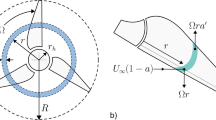Abstract
The marine hydropower system proposed in this study creates a tidal jet generator from a seawater exchange type breakwater, with empty space similar to a basin to store ocean water. Due to the water level difference between the inner and outer sides of the breakwater, strong and uni-directional jets are generated. The energy from the jets is captured by turbines in the breakwater ducts.
In this study, the proposed system is first introduced. The design process for a new turbine and its preliminary performance in openwater conditions, estimated using Computational fluid dynamics (CFD), are presented. Experiments with the turbine in a Circulating water channel (CWC) at Pusan National University were also carried out. The results from the simulations and experiments with the same conditions were compared to verify the CFD accuracy. The turbine performance in a duct is estimated; the target power can be generated using the newly developed turbine.
Similar content being viewed by others
References
J. C. Park, T. Okada, T. K. Furukawa and K. Nakayama, Numerical study on the flow characteristics of tidal jets induced by a tidal-jet-generator, Ocean Engineering, 33 (14) (2006) 1896–1918.
K. Furukawa and Y. Hosokawa, A three dimensional physical-biological modeling and its application to evaluation of nitrogen uptake at coast, Report of the Port and Harbour Research Institute, 33 (3) (1994) 27–56.
S. Akeda, Y. Yamamoto, K. Kimura and K. Yano, Design and construction of seawater exchange breakwaters, Proceedings of 26th Conference on Coastal Engineering, ASCE (1998) 1539–1552.
O. Paish, Small hydro power: Technology and current status, Renewable and Sustainable Energy Reviews, 6 (6) (2002) 537–556.
H. M. Ramos, A. Borga and M. Simão, New design solutions for low-power energy production in water pipe systems, Water Science and Engineering, 2 (4) (2009) 69–84.
I. Samora, V. Hasmatuchi, C. Münch-Alligné, M. J. Franca, A. J. Schleiss and H. M. Ramos, Experimental characterization of a five blade tubular propeller turbine for pipe inline installation, Renewable Energy, 95 (2016) 356–366.
J. Haristy, The Analysis of Tidal Stream Power, John Wiley & Sons (2009) 342.
D. K. Okot, Review of small hydropower technology, Renewable and Sustainable Energy Reviews, 26 (2013) 515–520.
M. Shahsavarifard, E. L. Bibeau and V. Chatoorgoon, Effect of shroud on the performance of horizontal axis hydrokinetic turbines, Ocean Engineering, 96 (2015) 215–225.
C. F. Fleming and R. H. Willden, Analysis of bi-directional ducted tidal turbine performance, International Journal of Marine Energy, 16 (2016) 162–173.
B. Huang, Y. Nakanishi and T. Kanemoto, Numerical and experimental analysis of a counter-rotating type horizontalaxis tidal turbine, Journal of Mechanical Science & Technology, 30 (2) (2016) 499–505.
Author information
Authors and Affiliations
Corresponding author
Additional information
Recommended by Associate Editor Donghyun You
Se-Min Jeong is currently an Assistant Professor at Department of Naval Architecture & Ocean Engineering, Chosun University, Korea. He received his B.S. and M.S. from Department of Naval Architecture at Inha University, Korea, in 1995 and 1997, respectively. He obtained his Ph.D. in Environmental & Ocean Engineering from the University of Tokyo, Japan, in 2007. His research interests focus on computational physics especially regarding thermal and fluid systems.
Jong-Chun Park obtained his M.S. and Ph.D. degrees from Department of Naval Architecture and Ocean Engineering at University of Tokyo, Japan, in 1991 and 1994, respectively. He is currently a Professor in Department of Naval Architecture & Ocean Engineering at Pusan National University, Korea. His research interests are in the areas of Computational Fluid Dynamics, multi-physics and fluid-structure interaction.
Rights and permissions
About this article
Cite this article
Jeong, SM., Kim, SO., Lee, HS. et al. Simulation of hydropower turbine performance in duct for system utilizing tidal jet generator. J Mech Sci Technol 31, 5871–5877 (2017). https://doi.org/10.1007/s12206-017-1130-0
Received:
Revised:
Accepted:
Published:
Issue Date:
DOI: https://doi.org/10.1007/s12206-017-1130-0



